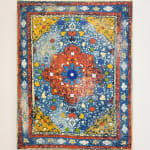Kour Pour UK, b. 1987
Little Wanderer, 2022
Acrylic on canvas over panel
9 x 7 x 1.5 in
22.9 x 17.8 x 3.8 cm
22.9 x 17.8 x 3.8 cm
8341
Los Angeles-based artist Kour Pour (b. 1987, UK) is on the vanguard of a movement towards intercultural depictions of the contemporary world. His perspective as an Iranian-British person who immigrated...
Los Angeles-based artist Kour Pour (b. 1987, UK) is on the vanguard of a movement towards intercultural depictions of the contemporary world. His perspective as an Iranian-British person who immigrated to the United States profoundly informs the subject matter that drives his painting practice. The layers of meaning and content embedded in Pour's paintings reference the many areas of culture in which identity and aesthetics intersect.
This miniature Persian Carpet Painting by Pour is representative of the artist’s ongoing interest in issues of intercultural representation. The work is made by layering various techniques, including the brushing of gesso to create a crosshatch foundation; screenprinting; drawing; sanding away parts of the image; and finally hand painting the finishing touches. Among the central ideas Pour works with is the question of what is visible in cultural history versus what gets erased.
Born in the United Kingdom to an Iranian father and British mother, Pour recalls the most common question he has been asked throughout his life: “Where are you from?” He would always answer with the name of the town where he grew up, but what people were really inquiring about was his bi-cultural heritage. In part an effort to overcome his resentment of this attempt by the majoritarian culture to other him, and in part out of sheer curiosity, Pour began asking the same question about all kinds of things, especially art. If everything is influenced by something else, and culture and information flow freely around the world today more than ever, how can we declare with certainty where anything is truly from?
Pour’s father, who left Iran at age 14 during the revolution, owned a small carpet shop in Exeter, and Pour would spend time there as a child. He learned that the history of Persian carpets encapsulates the history of the entire world, with visual influences from China, India, Japan, Korea, and Russia, and methods and materials influenced by cultural exchanges with Europe.
The process Pour uses to make these carpet paintings speaks to the most important part of this heritage—the intercultural nurturing of images, materials, and techniques across time and space.
This miniature Persian Carpet Painting by Pour is representative of the artist’s ongoing interest in issues of intercultural representation. The work is made by layering various techniques, including the brushing of gesso to create a crosshatch foundation; screenprinting; drawing; sanding away parts of the image; and finally hand painting the finishing touches. Among the central ideas Pour works with is the question of what is visible in cultural history versus what gets erased.
Born in the United Kingdom to an Iranian father and British mother, Pour recalls the most common question he has been asked throughout his life: “Where are you from?” He would always answer with the name of the town where he grew up, but what people were really inquiring about was his bi-cultural heritage. In part an effort to overcome his resentment of this attempt by the majoritarian culture to other him, and in part out of sheer curiosity, Pour began asking the same question about all kinds of things, especially art. If everything is influenced by something else, and culture and information flow freely around the world today more than ever, how can we declare with certainty where anything is truly from?
Pour’s father, who left Iran at age 14 during the revolution, owned a small carpet shop in Exeter, and Pour would spend time there as a child. He learned that the history of Persian carpets encapsulates the history of the entire world, with visual influences from China, India, Japan, Korea, and Russia, and methods and materials influenced by cultural exchanges with Europe.
The process Pour uses to make these carpet paintings speaks to the most important part of this heritage—the intercultural nurturing of images, materials, and techniques across time and space.



